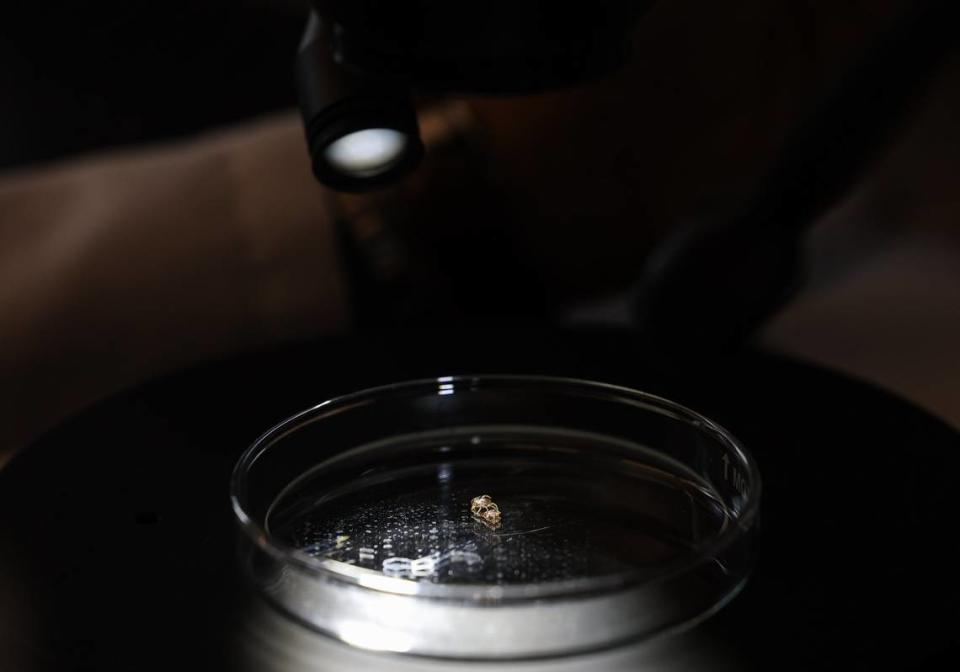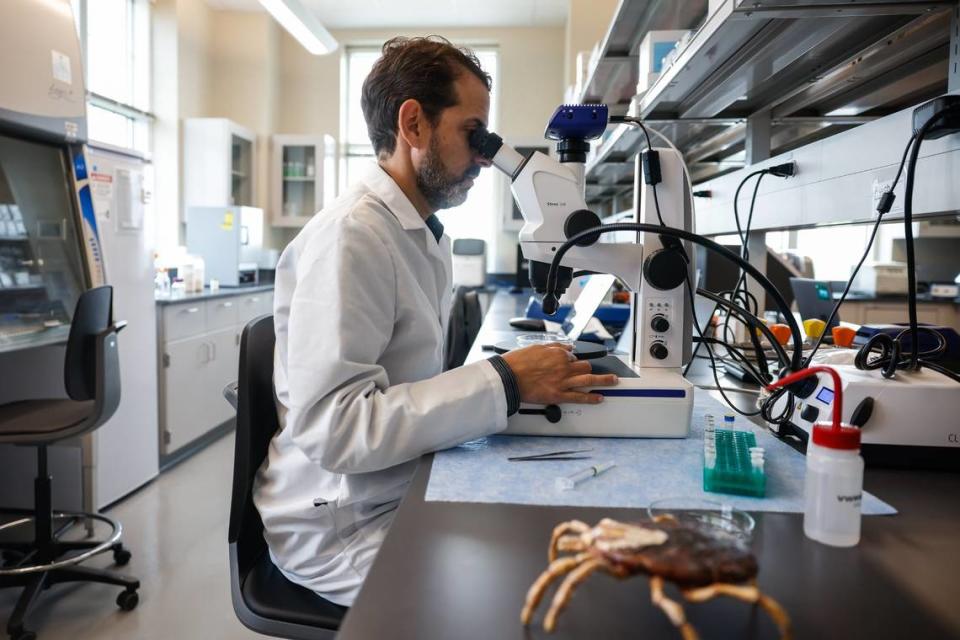UNC Charlotte enters ‘next chapter’ after earning coveted top-tier research status
Morgan Carter’s hikes outdoors take ages.
The UNC Charlotte researcher is constantly stopping along her route to inspect fungi clinging to a leaf here or a branch there.
“I’ll stop and say ‘What is that?’ and have to look,” she said. “It drives my husband crazy.”
Carter studies how fungi and bacteria behave together and affect plants. She describes her lab as a sort of “sandbox” where students can explore research. It launched in 2023 as part of UNC Charlotte’s vast expansion of its research infrastructure over the past 10 years — an expansion that’s about to pay off.
UNC Charlotte will gain a prestigious new status in 2025 when it officially becomes an “R1” university. That designation is reserved for schools with the highest level of research investment and activity and currently applies to only 146 of the country’s nearly 4,000 universities.
The new designation also could be a signal that the university is primed to further boost the Charlotte economy to previously unseen heights.
Here's our latest accountability reporting
Reality Check reflects the Charlotte Observer’s commitment to holding those in power accountable. Here are three of our stories from this week:
→ Charlotte Airport ranks 10th for delays, Frontier leads airlines
→ How April 29 went from normal day to tragedy in Charlotte
→ Union with little inroads at banks tries to organize Wells Fargo
What is R1 status?
Since 1973, the Carnegie Foundation for the Advancement of Teaching has released rankings of U.S. universities according to their level of research activity, with R1 – or “Research 1” status – being reserved for schools with “very high research activity.”
Charlotte is one of only two of the biggest 25 U.S. metropolitan areas without an R1 school — the other is Portland, Oregon.
“In some sense, it’s just a label, but it’s what’s behind that label and what that symbolizes in terms of independent, external validation,” John Daniels, chief research officer at UNC Charlotte, told The Observer. “It says ‘Yeah, UNC Charlotte has that broad potpourri of activities that are resident at any other large institution in the Carolinas, and our industry partners don’t have to go somewhere else when seeking solutions.”
There are three R1 schools in North Carolina: UNC Chapel Hill, Duke University and North Carolina State University. The closest R1 school to Charlotte geographically is the University of South Carolina in Columbia.
“A lot of people used to tell me when I first got here ‘Well, we try to work with other R1’s in North Carolina, but they’re a couple of hours away,’” UNC Charlotte Chancellor Sharon Gaber told The Charlotte Observer. “Every great city has a great research university … Charlotte deserves that.”

This year, the criteria are changing. While it used to be determined by complicated calculations, with a cap on the number of schools with the designation, there are now benchmarks across the board.
To qualify as R1, a school must spend at least $50 million on research each year and award at least 70 research doctorates annually. In 2023, UNC Charlotte spent just over $55.2 million on research (up from $43.1 million in 2022) and awarded 156 research doctorates.
As part of the university’s strategic plan, Gaber says the university aims to increase its total research spending to $125 million by 2031.
Charlotte isn’t alone in its upgrade. With the new criteria, the total number of R1 schools is projected to increase from 146 to 168. UNC Charlotte and East Carolina University are the two schools in the state projected to be elevated in 2025.
Daniels says he’s not concerned about the competition from the 22 new schools vying for top faculty and students.
“We really have a focus on a culture where people are able to function and thrive in their research,” Daniels said. “We also benefit from being in a vibrant city that faculty are attracted to.”
He noted the new research status is just one metric showing UNC Charlotte making major moves. Between 2023 and 2024, the school jumped 41 spots in U.S. News and World Report’s National University Ranking, from 219th to 178th. The U.S. News college ranking is one of many, but it’s generally considered the most influential when it comes to shaping public opinion. Students and families turn to it as a resource when choosing what school to attend.
What does research at UNC Charlotte look like?

Part of UNC Charlotte’s strategy has been building several on-campus research centers.
“We were founded in 1946, and as a young institution, we can’t grow in every conceivable discipline overnight,” Daniels said. “We’ve had to invest in very strategic areas. Research is almost always cross-disciplinary in order for solutions to actually have impact in the real world. A research center can pull together faculty from different departments in specific areas.”
One such center is CIPHER, which stands for Computational Intelligence to Predict Health and Environmental Risks. The 25,000-square-foot center opened in January 2023 as part of UNC Charlotte’s push to drastically expand its research activities. There, scientists investigate how microbes interact with things like genetics to impact health outcomes.
Carter is an assistant professor who runs a lab at CIPHER that studies how fungi and bacteria interact.
“Fungi are actually very similar to humans, so it’s hard to develop drugs that target fungi but don’t hurt humans,” she said.
She showed off three Petri dishes, each filled to the brim with an unfurling fuchsia bloom of fungus.
“These are the ones that attack watermelon plants,” she said.
Her lab has samples of plants that she and her lab assistants, a mix of undergraduate and graduate students, inspect for fungal growth. The goal is to discover more about how fungi and bacteria interact to affect the host’s health.
“We have so many students that want to get into labs, but it can be hard to accommodate all of them,” Carter told The Observer. “I’m excited for more research resources as a result of R1 status.”

Down the hall from Carter, Adam Reitzel has about 100,000 sea anemones.
“We’ve found that anemones from off the coast of North Carolina are incredibly different, genetically, from those found in, say, Massachusetts,” Reitzel said while standing amid a menagerie of glass containers filled with anemones, jellyfish and coral.
His lab also examines how coastal invertebrates are adapting genetically to climate change.
Researchers at CIPHER study human disease, too.
Danillo Augusto studies how human genes affect immunity. Just two weeks ago, Augusto published a study in the prestigious journal Nature about a genetic marker present in people who are likely to develop multiple sclerosis, a chronic autoimmune disease that affects the central nervous system.
“With this, we can potentially help people identify if they have that variant even 10 years before they actually develop symptoms of the disease,” Augusto said. “There’s no cure for MS, but, hopefully, this can help us intervene early.”
Augusto, who’s from Brazil, says he’s particularly interested in developing more research on underrepresented populations.
“Most of the data we have so far in this field are from people with European ancestry,” Augusto said. “So, I’m interested in looking at more diverse populations.”
What is the economic impact?

Top-tier research status is more than just a feather in the school’s cap. The presence of an R1 university in Charlotte has the potential to be a catalyst in the city’s economy.
“The university has the opportunity to spin out some of its patents and research into businesses and startups,” said Rob Horton, chief marketing and communications officer for the Charlotte Regional Business Alliance. “Our ability to attract companies that heavily rely on university partnerships will increase.”
Charlotte’s workforce is already growing rapidly: an average of 113 people move here everyday, and 60% of those are between the ages of 25 and 54. Charlotte civic leaders, including former Bank of America CEO and UNC Charlotte trustee Hugh McColl, are pushing for the creation of a North Tryon tech district, an entrepreneur hub in uptown. The project would be a collaboration between UNC Charlotte and Charlotte Center City Partners, modeled after a similar initiative in Atlanta backed by Georgia Tech.
“The university has patents that are ready to be commercialized,” Horton said. “I think this will help to continue to strengthen Charlotte’s growth trajectory.”
For each new university patent, researchers estimate 15 additional jobs are created outside the university in the local economy, according to a study from Harvard University. In a city growing as rapidly as Charlotte, it may be more. UNC Charlotte ranked fourth in the nation for new start-up companies per research dollar in 2024, putting it ahead of any other university in North Carolina.
“A lot of companies want to have very strong research universities and access to the talent and innovation that come out of them,” said Gaber. “It helps to stimulate economic development opportunities.”
Malcolm Graham is a Charlotte City Council member and chair of its economic development committee. He called the designation “a game changer for Charlotte.”
“It definitely bodes well for the economic vitality of the city,” Graham told The Observer.
Daniels agrees.
“We’re in a day and age where companies choose where to relocate their headquarters, and part of that calculus is ‘What does that talent pipeline look like? What does the research capacity look like?’” he said. “So I think it means a lot for the next chapter of Charlotte and for North Carolina.”


